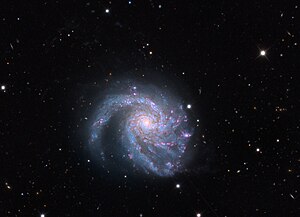Messier 99
| Galaxy Messier 99 |
|
|---|---|

|
|
| Image in the visible spectral range with the 81 cm reflecting telescope of the Mount Lemmon Observatory | |
| AladinLite | |
| Constellation | Berenike's hair |
|
Position equinox : J2000.0 , epoch : J2000.0 |
|
| Right ascension | 12 h 18 m 49.6 s |
| declination | + 14 ° 24 ′ 59 ″ |
| Appearance | |
| Morphological type | SA (s) c; LINER HII |
| Brightness (visual) | 9.7 likes |
| Brightness (B-band) | 10.4 mag |
| Angular expansion | 5.3 ′ × 4.6 ′ |
| Position angle | 51 ° |
| Surface brightness | 13.0 mag / arcmin² |
| Physical data | |
| Affiliation | Virgo galaxy cluster , LGG 285 |
| Redshift | 0.008029 ± 0.000010 |
| Radial velocity | +2407 ± 3 km / s |
|
Stroke distance v rad / H 0 |
(105 ± 8) · 10 6 ly (32.3 ± 2.3) Mpc |
| history | |
| discovery | Pierre Méchain |
| Discovery date | March 15, 1781 |
| Catalog names | |
| M 99 • NGC 4254 • UGC 7345 • PGC 39578 • CGCG 099-011 / 098-144 • MCG + 03-31-99 • IRAS 12162 + 1441 • 2MASX J12184962 + 1424593 • VCC 307 • GC 2838 • h 1173 • HIPASS J1218 +14 | |
Messier 99 (also known as NGC 4254) is a +9.7 mag bright spiral galaxy with an area of 5.3 '× 4.6' in the constellation Haar der Berenike .
M99 was discovered by Pierre Méchain on March 15, 1781, together with the neighboring spiral galaxies M98 and M100 . After the Whirlpool galaxy M51, it was the second galaxy whose spiral structure was discovered by Lord Rosse in 1846 . He commented on his discovery with the following lines:
“Spiral with a bright star above it; a thin part of the nebula extends beyond this star. The main spiral is at the bottom and turns clockwise. "
M99 is a Hubble-type Sc galaxy that we see almost head-on. What is peculiar about the shape of the galaxy, however, is its slipped core, which in the picture is clearly north of the center of the spiral. The galaxy is located on the northern edge of the Virgo Galaxy Cluster near the spiral galaxy M98 . There are speculations that the slipped core and the proximity of these two galaxies are not a coincidence, but rather indicate a flyby of each other in the past. This speculation is further fed by the fact that both galaxies have opposite and at the same time high peculiar velocities .
Drawing by William Parsons , 1848
Detailed study of the Hubble Space Telescope
VirgoHI21
Investigations by a team led by Pierre-Alain Duc in 2007 showed that the galaxy M98 (NGC 4192) is not only responsible for the deformation of M99, but also for the VirgoHI21 structure, which is a prototype of the dark galaxies . According to the investigations, M98 passed close to M99 750 million years ago at a relative speed of 1125 km / s, tearing away a great deal of hydrogen, which now forms the structure.
Web links
- M99 at SEDS
- Tidal Debris posing as Dark Galaxies . arxiv : 0707.3991
- A multi-beam HI survey of the Virgo Cluster - two isolated Hi clouds? arxiv : astro-ph / 0312531
- First dark galaxy found?
- Amateur recordings. Spektrum.de
Individual evidence
- ↑ a b c d NASA / IPAC Extragalactic Database
- ↑ a b c d e NGC 4254 SEDS
- ↑ Seligman
- ↑ (translation from English to messier.seds.org )
- ↑ messier.seds.org
- ↑ arxiv : 0707.3991
- ↑ Claudia Michalecz: Found the first dark galaxy? . Raumfahrer Net eV February 5, 2005. Retrieved September 9, 2019.





